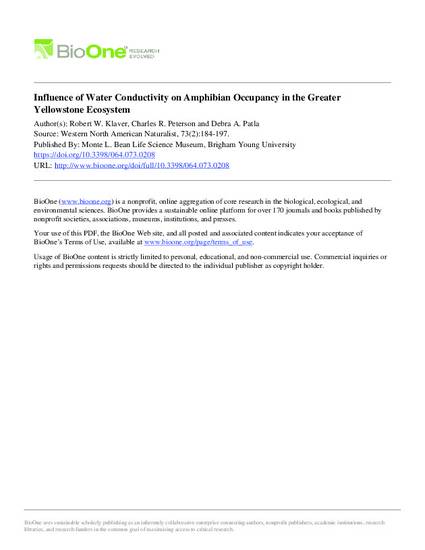
Investigation of amphibian occupancy at potential breeding sites can provide information about the distribution and relative abundance of species, as well as insights into habitat relationships across large areas such as national parks. Based on previous research in the Greater Yellowstone Ecosystem (GYE), we hypothesized that the probability of amphibian occupancy increases with water conductivity. We conducted amphibian surveys with habitat measurements at 235 wetland sites in the GYE in 2002, thereby locating breeding populations of boreal toads (Anaxyrus boreas), boreal chorus frogs (Pseudacris maculata), Columbia spotted frogs (Lithobates luteiventris), and barred tiger salamanders (Ambystoma mavortium). Repeat surveys provided detection probabilities, which allowed for unbiased estimates of occupancy. The boreal chorus frog was the most common amphibian in the GYE, with breeding populations occupying approximately 48% of the sites, followed by Columbia spotted frog (35%), barred tiger salamander (14%), and boreal toad (13%). Occupancy corrected for detection probability averaged 36% higher (range 27%–50%) than naive estimates of occupancy. Detection rates ranged from 0.65 to 0.78 for the 4 species. Modeling of habitat covariates indicated that higher conductivity was positively associated with toad occupancy but negatively associated with chorus frog occupancy; Columbia spotted frog and barred tiger salamander occupancy was little influenced by water conductivity. Fish presence had a negative effect on occupancy of barred tiger salamanders and boreal chorus frogs. These results may help managers in the GYE manage and conserve important breeding habitat for amphibians, particularly if longterm monitoring efforts indicate declines in amphibian populations.
Available at: http://works.bepress.com/robert-klaver/44/

This article is published as Klaver, Robert W., Charles R. Peterson, and Debra A. Patla. "Influence of water conductivity on amphibian occupancy in the Greater Yellowstone Ecosystem." Western North American Naturalist 73, no. 2 (2013): 184-197, doi: 10.3398/064.073.0208.